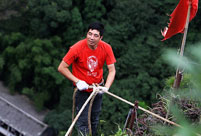Housing renovation plan makes this year's Eid-al-Adha more joyful in Xinjiang
Parhat Turson's hat shop is just across the street from Id Kah Mosque in Kashgar, the Xinjiang Uygur autonomous region, but he prays at China's largest mosque only during major Islamic festivals like Eid-al-Adha, which took place on Tuesday.
At 7:20 am, Parhat put on his finest suit for the biggest occasion of the year, which is also called Corban Festival by Uygurs. Although everyone in Xinjiang gets a five-day holiday, the 54-year-old shop owner decided to work as usual, putting handmade fur hats on the shelves outside his house in the old town of Kashgar.
He then went to his mosque for morning prayers before joining the large crowd outside, most of whom were led by their imams to Id Kah Mosque. By the time Parhat and more than 100 others from his mosque arrived at 9 am, the square in front of Id Kah was already packed with people carrying prayer mats. The inside of the mosque, which can accommodate up to 20,000 worshippers at prayer time, was full.
After the prayers, Parhat rushed home to slaughter the sheep that had been kept on the top floor of his house, according to tradition. "It is the second year we bought a sheep for Corban Festival. We couldn't afford them before," he said.
Parhat grew up in the old town, a 4-square-kilometer area in the heart of Kashgar that has a history of more than 2,000 years. It is home to 126,800 people, almost all of them Uygurs.
Parhat inherited the skill of making traditional Uygur fur hats from his father, as he did the shop where he sells them. The family's house was originally made of mud, but in 2009 it was rebuilt in brick and made to withstand earthquakes as a part of a project funded by the central government to renovate old-town Kashgar.
He said life has become cleaner and much more convenient since running water and sewerage were installed. Also, the road outside has been hardened, which has brought more people, especially tourists, to the 1,000-year-old Hat Bazaar, where Patar's house and shop is located.
"I used to make about 600 yuan ($98) a month before the renovation, because no one wanted to come to a dusty, stinky place to shop. Now I can make 3,000 yuan during the tourist season in the summer," he said, holding up and spinning a fur hat on his middle finger for a potential local buyer, who laughed about people buying fur hats while it was still hot.
The mazelike streets and small alleys of the old town may have been renovated, but the traditional Uygur architectural features and lifestyle have been maintained.
The renovation plan for each house was individually designed and the redecoration left to the owners. Some preferred to smear mud onto the brick walls to preserve the traditional look of their old mud houses, which could turn to dust in an earthquake. Some carefully paste triangle-shaped clay tiles all over the facades of their houses, and wooden sculptures with Uygur characteristics decorate the doors and windows.
By September, more than 85 percent of the decrepit houses in the central area of the old town had been renovated. The project, which will benefit more than 49,000 households, is due to be completed in 2014.
Electric motorcycles have become the most common means of transportation, now that the streets have been widened, but some still prefer carriages drown by horses with bells hanging from their necks. Though the carriages are banned on the main streets of Kashgar, they have long provided convenient shuttle services from one bazaar to another in the old town and can go just as fast as modern transportation.
The day before the festival, the old town was packed with sheep dealers selling animals for slaughter for 1,600 yuan and 5,000 yuan apiece, depending on the size. For every family, big or small, buying the perfect sheep is the most important part of preparing for the festival. For the children, herding or dragging the sheep back to the houses for slaughter is a game of fun — and one they sometimes lose.
Besides bakers and hairdressers, knife sharpeners are also doing good business ahead of the festival. Knives must be kept sharp, both for slaughtering and cutting up the animals.
A line had formed in front of almost every shop in Mattock Bazaar on Monday, with various kind of knives and axes on display. All day long, the sounds and sparks from the grinding machines filled the street for iron products.
Parhat said he will close his shop on Wednesday to visit relatives. He will bring them the good news that by the next Corban Festival, he will be cooking on natural gas instead of coal.

 2013 Colour Me Rad 5K run held in Canada
2013 Colour Me Rad 5K run held in Canada China's destroyer Qingdao sails out of Sydney Harbor
China's destroyer Qingdao sails out of Sydney Harbor Chinese tycoon aims to restore London's Crystal Palace
Chinese tycoon aims to restore London's Crystal Palace Worst flooding hits Yuyao, 70% of downtown area underwater
Worst flooding hits Yuyao, 70% of downtown area underwater Game for the brave: 'Spiders' in Yandang Mountains
Game for the brave: 'Spiders' in Yandang Mountains Hungarian wingsuit flyer confirmed dead in Zhangjiajie
Hungarian wingsuit flyer confirmed dead in Zhangjiajie Chinese screen goddesses from Beijing Film Academy
Chinese screen goddesses from Beijing Film Academy  Weekly Sports Photos
Weekly Sports Photos World's most amazing yacht on display in Guangzhou
World's most amazing yacht on display in Guangzhou Photo collection of Chinese Navy
Photo collection of Chinese Navy Photo story: Young tenants in Beijing
Photo story: Young tenants in Beijing Twins Culture Festival kicks off in Beijing
Twins Culture Festival kicks off in Beijing UNESCO world heritage site: Montale Tower
UNESCO world heritage site: Montale Tower Israeli drone crashes into Mediterranean, fragments recovered
Israeli drone crashes into Mediterranean, fragments recovered Fiber-optic wedding dress show shinning in Suzhou
Fiber-optic wedding dress show shinning in Suzhou Day|Week|Month